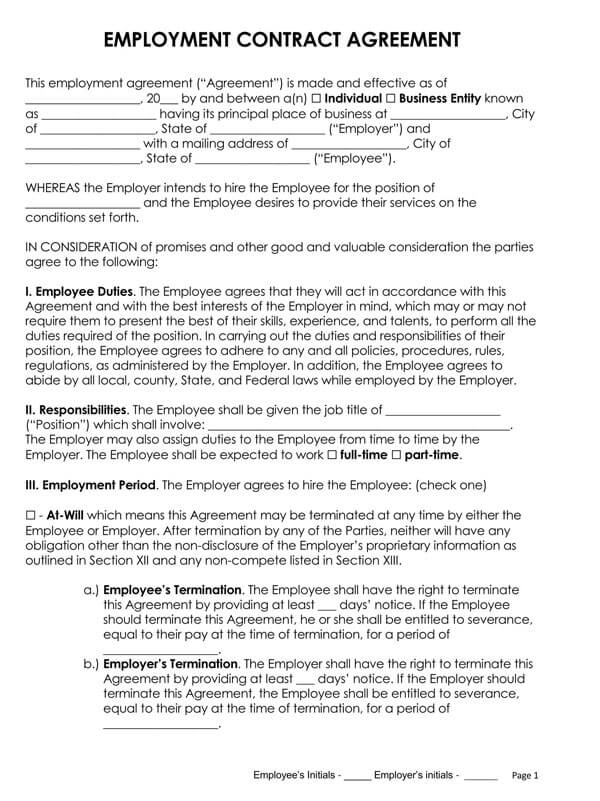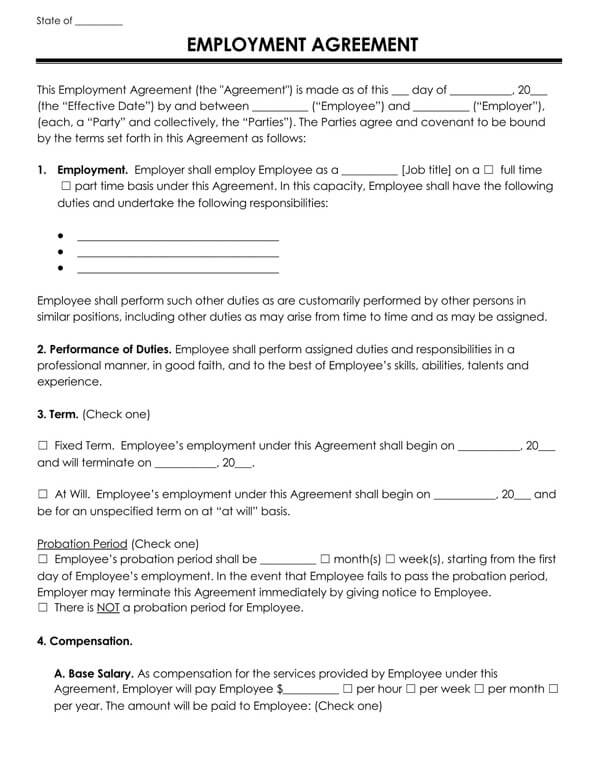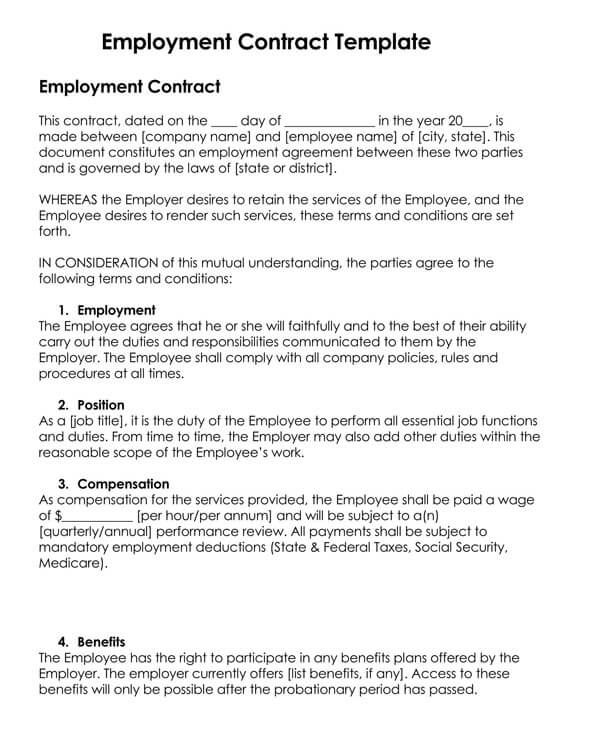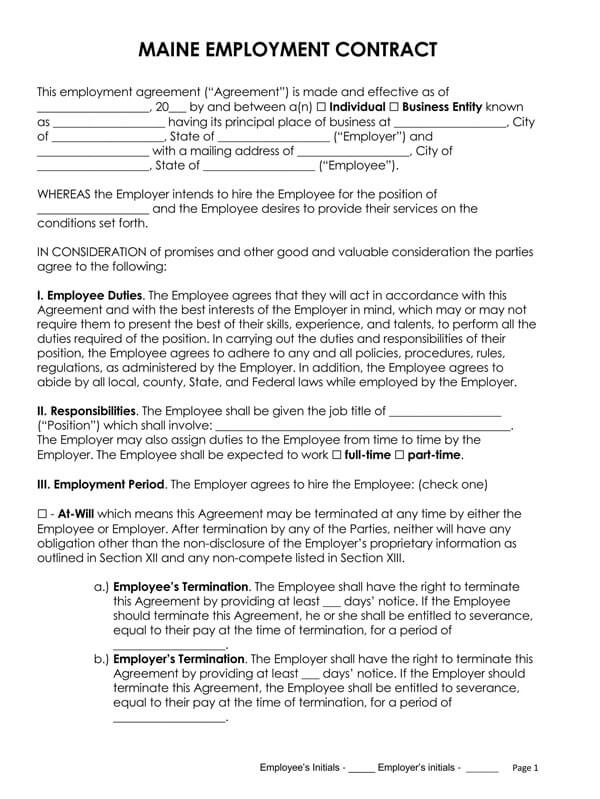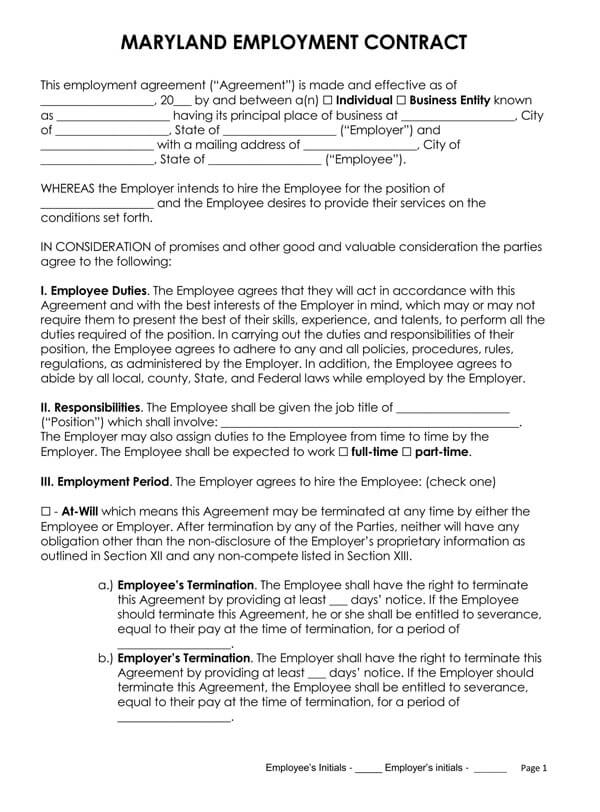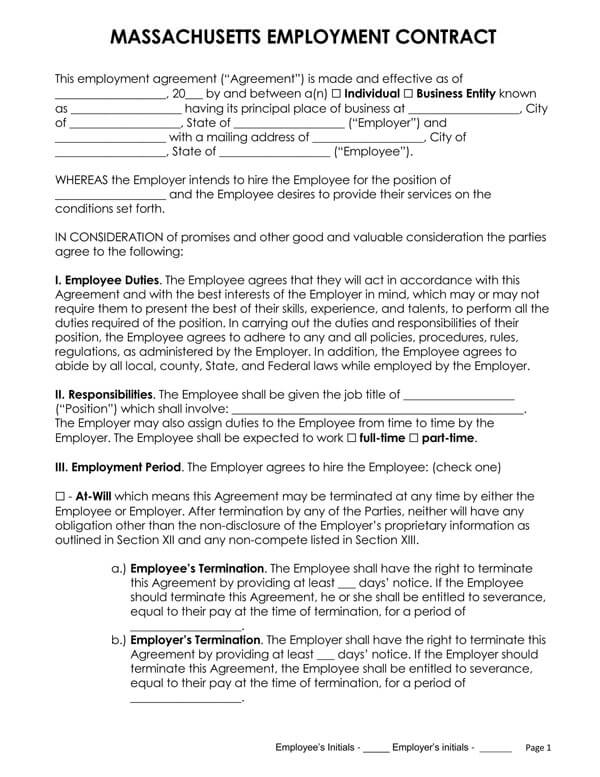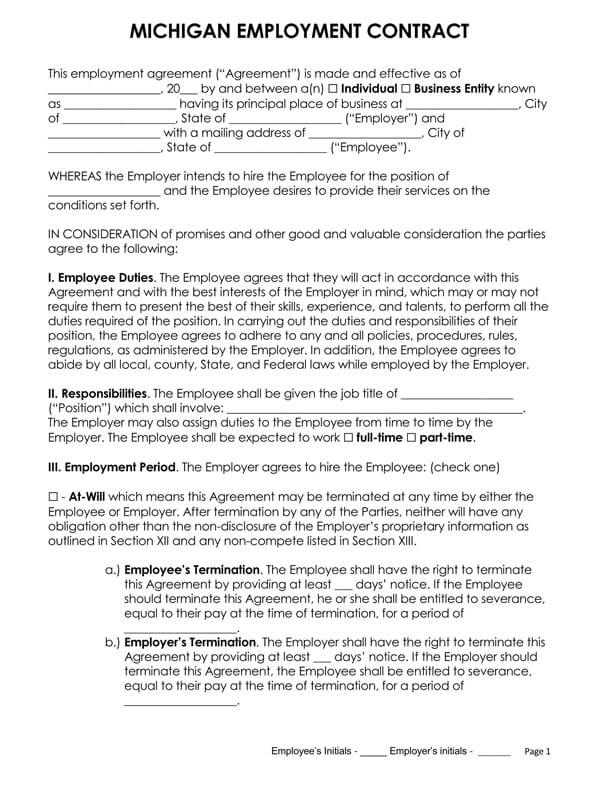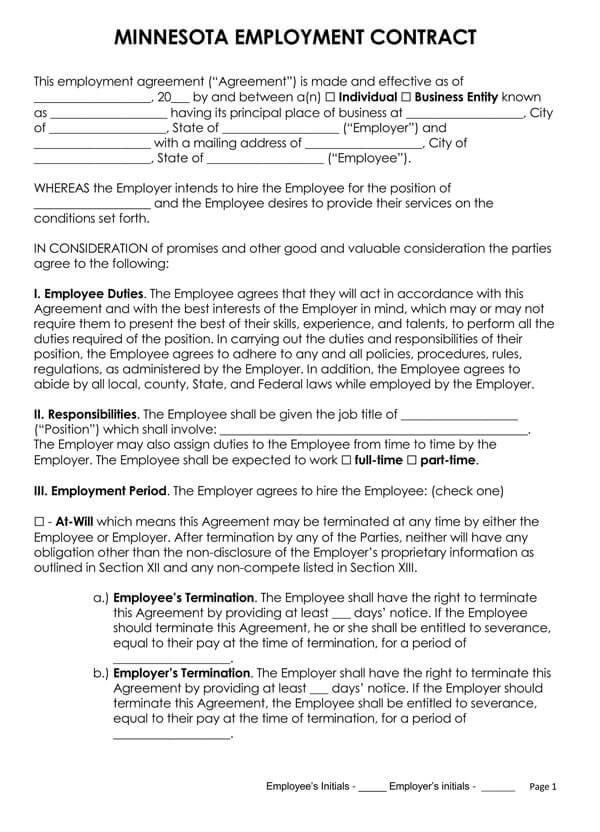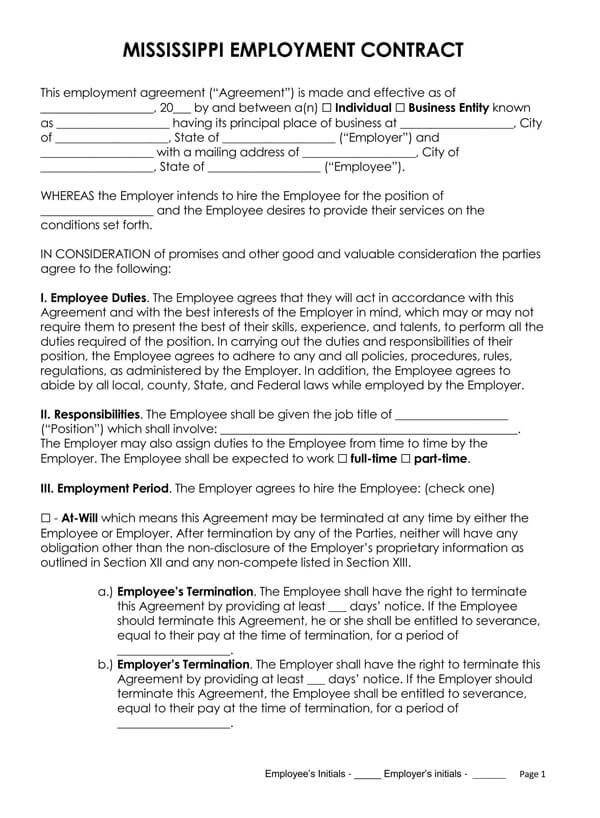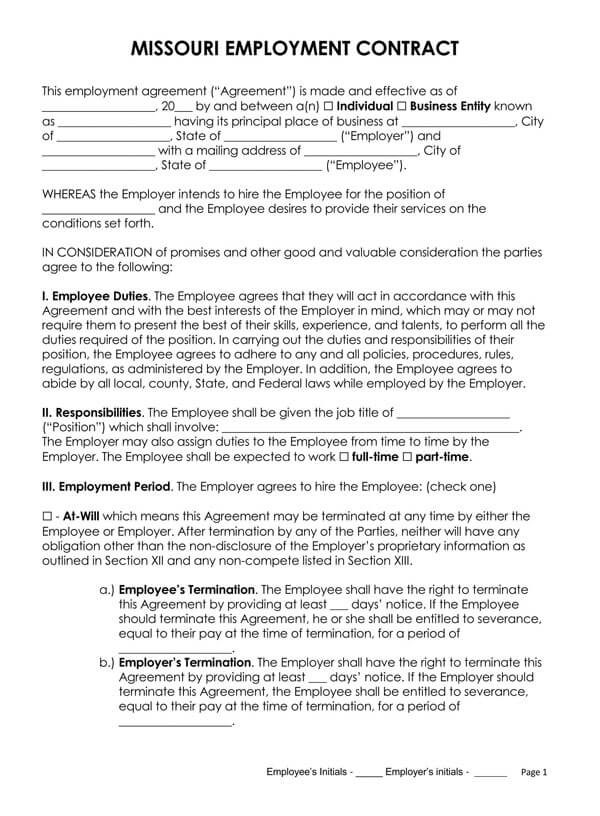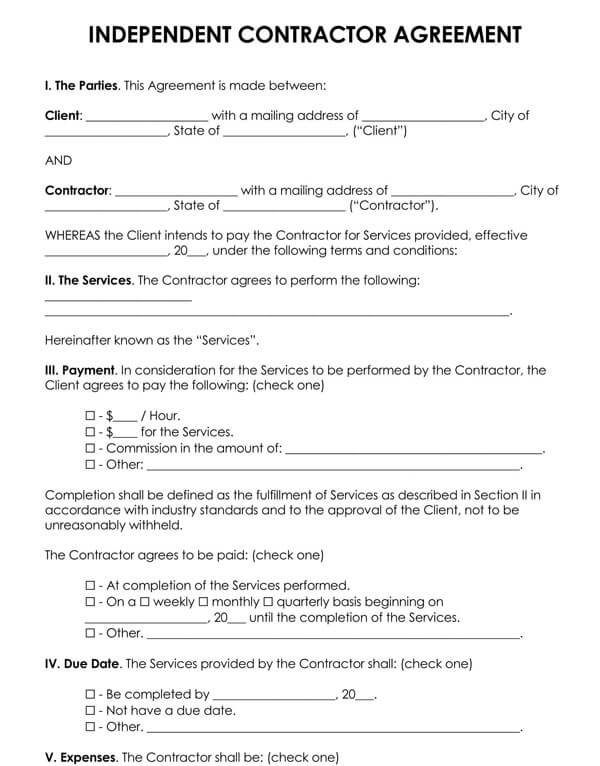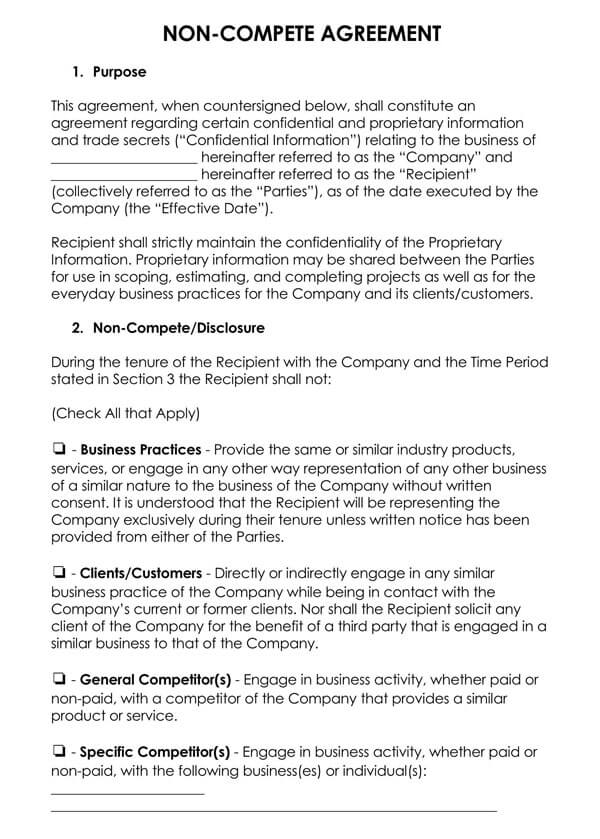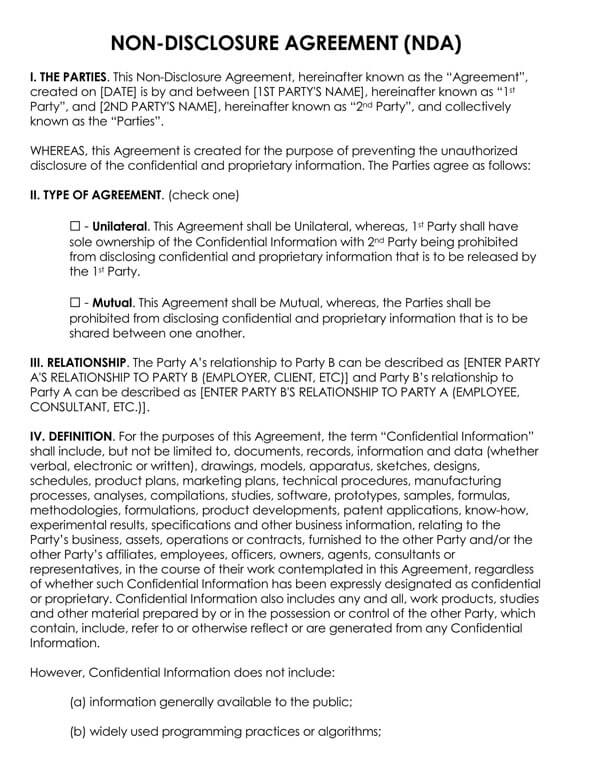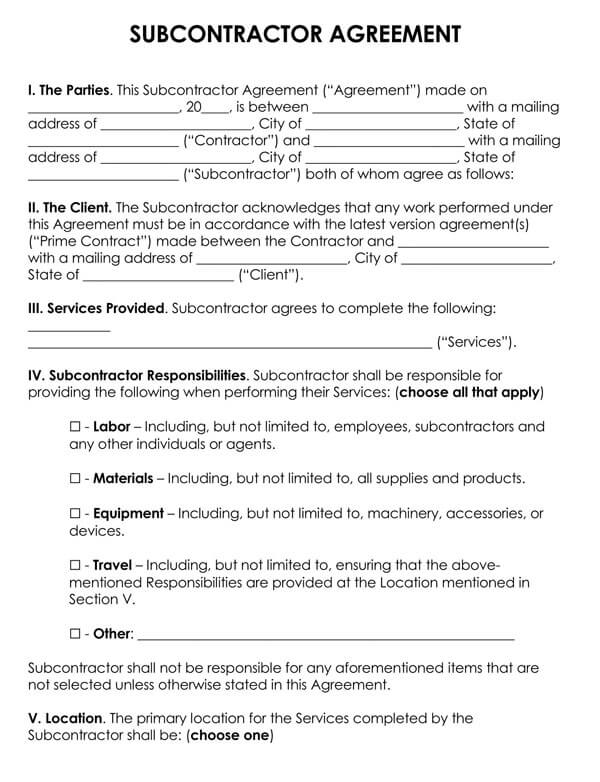An employment contract is a contract between an employer and an employee. It is an agreement between an employer and an employee to create a new employment relationship. You, as the employer, recruit and pay an employee, freelancer, independent contractor, or subcontractor.
The employment contract template contains information such as the employee duties, benefits, termination, type of compensation, and liability of the parties involved. Depending on the country’s laws, an employee may be liable to pay payroll taxes withheld by an employer.
An employment contract has other similar names such as job contract, contract of employment, employment agreement, employee contract, contract of service, work contract, and contract of service.
Circumstances requiring an employment contract usually include;
- When you are hiring an employee, and you want them to sign a non-disclosure/confidentiality agreement.
- When you want to inform your employee that he/she is an at-will employee.
- When you want your new employee to understand the working relationship.
- When you have agreed verbally with your employees and need formal agreements.
IRS Form W-4: An employee is required to complete an IRS form W-4 at the beginning of employment. An IRS W-4 form helps you determine the amount of money to deduct from an employee’s paycheck for tax purposes.
IRS Form W-9: An independent contractor is required to complete an IRS form W-9 at the beginning of employment. The IRS W-9 form is often used to produce a 1099 tax form, which is necessary for income tax filing purposes.
The following people require employment contracts:
Employers: Employers need an employment contract if they don’t want competition when an employee leaves a similar company, when an employer wants an employee to keep company information confidential and when an employee doesn’t want to lose a highly skilled employee to a competing firm.
Human Resource Managers: HR managers needs an employment contract to record information of employees such as names, addresses, etc.
Recruitment Officers: Recruitment Officers preparing to enlist a new hire need an employment contract to show proof of employment.
Employees: Employees need employment contracts to safeguard their rights and benefits such as health insurance.
Recruits: Recruits whose employers do not use job contracts need employment contracts to ensure they are given employee benefits like pensions.
Types of Employment Contracts
Documenting the types of employment contracts in writing is not only a legal necessity. It also allows you to protect your company and manage relations with staff.
Below are the different types of employment contracts:
Independent contractor contract
An independent contractor is a person or organization that you pay to perform certain services. They are considered as a 1099 employee by the Internal Revenue Service. They include lawyers, doctors, contractors, etc.
Non-compete contract
This type of employment contract disallows your employee to work for your competitors in the same field as you. But it depends on the restrictions you have outlined.
Non-disclosure contract
Non-disclosure agreements bring about confidentiality. By signing this type of contract, your employees are required to keep any information you provide confidentially.
Subcontractor contract
This is an agreement made between a subcontractor and a contractor. When your company has an agreement with a contractor, the contractor then uses a subcontractor agreement to fulfill parts of the initial agreement by recruiting other specialists.
Trial period contract
The other name for the trial period is the probationary period. This is when you hire an employee without commitments. You hire employees to see how they cope with the company, and at the end of the trial period, which is a date included in the contract, you will decide whether you will keep the employee or terminate the contract. If you choose to retain the employee, other worker benefits will be triggered, such as health insurance.
Part-time vs full-time contract
An employee working from 30-40 hours a week is generally considered qualified for full-time employment. Full-time work is typically defined by maximum hours (40 hours) in a week before overtime is needed. The payment for overtime is at least one and a half times pay.
Fixed-term contract
Fixed-term contracts have a fixed end date, e.g., six months. You will want to consider this form of a contract if you want to cover maternity leave, a large project for workers, or if you want to recruit interns. Fixed-term workers are covered and have the same privileges as permanent employees.
Interns or apprentices contract
Interns and workers possess different legal rights. An intern, for example, is neither covered from termination nor eligible for a minimum wage. However, an internship agreement may be considered an employment contract, and the intern would also be protected as an employee.
Employment vs Independent Contractor’s Agreement
An employee has state and federal taxes deducted from their salary while independent contractors pay the taxes independently.
The other differences are:
Employees
- Complete the IRS form W-4
- Has a pension
- Are paid by the hour/salary
- They work for your organization
Independent contractors
- They complete the IRS form W-4
- They are paid per project
- Do not have an unemployment insurance
- They work for their organization
Minimum wage
In the United States, the minimum wage under 29$206 a and c, which states that trade employees; home employees in Puerto Rico and the Virgin Islands, workers in American Samoa, crewmen on American vessels, and agricultural workers are to be paid at rates of $7.25 per hour. Although in some states, the rates are higher than that.
Income tax brackets
An individual’s tax bracket depends on how much they make, their marital status, the number of children, and the state in which they live. The overall tax liability of the person is a blend of federal and state taxes. If an individual lives in a major city such as New York City, they could also have a city tax. The IRS published the annual inflation updates for the tax year 2021, all of which are shown in the revenue process 2020-45. The modifications updated some tax brackets to account for increasing inflation.
Federal Tax Bracket
| Bracket | Single | Married (Joint) | Married (Separate) | Head of Household |
| 10% | $0 – $9,950 | $0 – $9,950 | $0 – $9,525 | $0 – $14,200 |
| 12% | $9,951 to $40,525 | $9,951 – $40,525 | $9,526 – $38,700 | $14,201 – $54,200 |
| 22% | $40,526 – $86,375 | $40,526 – $86,375 | $38,701 – $82,500 | $54,201 – $86,350 |
| 24% | $86,376 – $164,925 | $86,376 – $164,925 | $82,501 – $157,500 | $86,351 – $164,900 |
| 32% | $164,926 – $209,425 | $164,926 – $209,425 | $157,501 – $200,000 | $164,901 – $209,400 |
| 35% | $209,426 – $523,600 | $209,426 – $314,150 | $200,001 – $300,000 | $209,401 – $523,600 |
| 37% | Over $523,600 | Over $314,150 | $300,000 | Over $523,600 |
State Income Tax Brackets
| State | Income Tax Brackets | Laws |
| Alabama | 2 to 5% | § 40-18-5 |
| Alaska | 0% | N/A |
| Arizona | 2.9% to 5.17% | § 43-1011 |
| Arkansas | 0.9% to 6.90% | § 26-51-201 |
| California | 1% to 9.3% | RTC § 17041 |
| Colorado | 4.63% | § 39-22-104(1.7) |
| Connecticut | 3% to 6.99% | § 12-700 |
| Delaware | 2.2% to 6.6% | § 1102 |
| Florida | 0% | N/A |
| Georgia | 1% to 5.75% | § 48-7-20 |
| Hawaii | 1.4% to 11% | § 235-51 |
| Idaho | 1.125% to 6.925% | § 63-3024 |
| Illinois | 4.95% | 35 ILCS 5/201(b)(5.4) |
| Indiana | 3.23% | § 6-3-2-1 |
| Iowa | 36% to 8.98% | § 422.5 |
| Kansas | 3.1% to 5.7% | § 79-32,110(2)(F) |
| Kentucky | 5% | § 141.020 |
| Louisiana | 2% to 6% | § 47:32 |
| Maine | 5.8% to 7.15% | § 5111-1-F |
| Maryland | 2% to 5.75% | § 10-105(a) |
| Massachusetts | 5.3% | § 62-4 |
| Michigan | 4.25% | § 206.51(b) |
| Minnesota | 5.35% to 9.85% | § 290.06 |
| Mississippi | 3% to 5% | § 27-7-5 |
| Missouri | 1.5% to 6% | § 143.011 |
| Montana | 1% to 6.9% | § 15-30-2103 |
| Nebraska | 2.46% to 6.84% | § 77-2715.03 |
| Nevada | 0% | N/A |
| New Hampshire | 5% | § 77:1 |
| New Jersey | 1.4% to 8.97% | § 54A:2-1(b)(5) |
| New Mexico | 1.7% to 4.9% | § 7-2-7(C) |
| New York | 4% to 8.82% | § 601 |
| North Carolina | 5.25 % | § 105-153.7 |
| North Dakota | 1.10% to 2.90% | § 57-38-30.3 |
| Ohio | 0% to 4.997% | § 5747.02 |
| Oklahoma | 0.5% to 5% | § 68-2355(C) |
| Oregon | 5% to 9.9% | § 316.037 |
| Pennsylvania | 3.07% | 72 P.S. § 7302 |
| Rhode Island | 3.75% to 5.99% | § 44-30-2.6 |
| South Carolina | 0% to 7% | § 12-6-510 |
| South Dakota | 0% | N/A |
| Tennessee | 3% | § 67-2-102 |
| Texas | 0% | N/A |
| Utah | 4.95% | § 59-10-104 |
| Vermont | 3.55% to 9.40% | § 5822(a)(3) |
| Virginia | 2% to 5.75% | § 58.1-320 |
| Washington | 0% | N/A |
| Washington D.C. | 4% to 8.95% | § 47-1806.03 |
| West Virginia | 3% to 6.5% | § 11-21-4e |
| Wisconsin | 4% to 7.65% | § 71.06(1q) |
| Wyoming | 0% | N/A |
Essential Clauses to Include
As an employer, you should always include clauses that protect you and your employees from various circumstances.
The three clauses you should include are:
Non-compete
This clause prevents your employee from working with your competitors during and when they are no longer working for you. This clause usually lasts for a certain time post-termination and must comply with certain conditions, such as being limited to a sensible geographical area.
Non-solicitation
This clause keeps your employees from inciting other employees or clients to move to another organization. These clauses should comply with certain requirements to be considered legitimate and usually last for a definite time.
Confidentiality clause
This clause ensures that any work information you give to your employees remains confidential, and they cannot disclose such information to unauthorized personnel. It prevents employees/former employees from sharing or using business secrets, marketing strategies, and product details without the company’s permission. Confidentiality clauses can last forever or have an expiry date.
Crafting an Employment Contract Template
Before you employ anyone, you need to make sure that you and the job seeker are on the same page. This is done by using an employment contract template. There are many important elements of an employment agreement that you need to include in an employment contract template before you hire.
They are:
Employer information
Write your name on the blank space requiring the employer’s name in the employment contract template. You will also proceed to give your street address, city, and state where your business is located.
Employee information
This section requires information about the person you are hiring. The information required includes their name, street address, city, and state.
Job title/position
There is a section that will require you to write the position in which the individual you are hiring will take—for example, accountant. Proceed to state the duties/responsibilities he/she will be undertaking.
Compensation
Compensation includes the pay you will be giving the employee. It can be weekly, hourly or monthly. Include bonuses or overtime if there is any.
Employment terms
This is the period in which the employee will be working for your company. It can be at will or for a specified period. In an at-will situation, state the number of days your employee should notify you if they intend to terminate the contract. If the employment is for a specific amount of time, you must give the start and end date.
Benefits
Benefits include health insurance, off days, sick days, maternity leave, 401(K), and any other benefits your company offers.
Confidentiality/non-disclosure clause
Remember to include a confidentiality/non-disclosure clause here. This clause ensures that the employee will not share your company’s information while working for you or with future employers.
Non-compete clause
This clause in the employment contract template prevents the employee from working with companies you compete with when they leave your company.
Non-solicitation clause
This agreement ensures that an employee will not encourage other staff to move with them to another company when they leave.
Termination procedure
State the conditions that will cause the employment contract to be terminated. If an employee wants to end the contract, give the number of days’ notice they must give.
Agency provision
This clarifies that an employee cannot enter into a contract on your behalf unless there is written permission.
Probationary period
Also known as a trial period. It is the duration when an employee will be on trial. After the stated period, you will decide if you will retain the employee or terminate the contract.
Work for hire
This clause in the employment contract template states that any creation by an employee in your company’s environment belongs to the company.
Printable Employment Contract Templates
As an employer, crafting employee contracts is like an almost everyday task. Our website will provide you with downloadable and easy-to-follow templates that will guide you in writing employee contracts. Our employment contract templates are detailed enough to guide you through this task. Feel free to try our employment contract templates.
Employment Contracts: By State
There are no basic conditions for an employment agreement under the laws of the United States. Also, in most states, no written memorization of any words is needed. The employment agreement in the United States is considered to be “at will,” i.e., terminable with or without cause or warning. Many workers in the United States are hired “at-will” without a formal employment agreement and only with a written employment offer that sets out the specific terms and conditions of their employment.
Here are free employment contract templates for each state that can be edited after being downloaded:
Agreement Templates by Type
Additional Guidelines for Hiring an Employee
Before you write an employment agreement, you should meet with the employee to discuss details such as salary, duties, and position.
In this section, we have explained step by step how to proceed with the hiring process:
Make a job posting
Use the internet to search for the top talents. Search for the specific skills that your company needs. There are different platforms for advertising different positions.
- For the executive positions, use: glass door.com, indeed.com, ladders.com, and career builders.com.
- For entry-level positions, use: simplyhired.com, monster.com, and craigslist.org.
- If you are looking for talent, use LinkedIn and Facebook.
Review incoming applications
After advertising for a job position, you will receive many applications from prospective candidates interested in the work. Go through the applications and shortlist the ones that suit your company best.
Set up interviews
Have a conversation with the potential employee to know more about them. Ask work-related questions to see how the candidate would react in certain circumstances at work. You can also conduct interviews virtually via skype, google, Facebook, and other virtual platforms.
Conduct a background check
Doing a background check on a candidate is advisable even if they are qualified. They might have a criminal record that will give you an idea of their unlawful actions.
There are websites where you can get a background check for a fee.
- GoodHire.com ($79.98)
- Kennect ($59.95)
- HireRight ($39.95)
- AccurateNow.com ( $24.95)
Negotiate terms
There are various terms that an employer and an employee should agree on.
They are:
- Employee duties and position in the company
- The period of employment, whether at-will or for a particular time.
- Whether you will be paying them on an hourly basis or salary, include bonuses if any.
- Benefits like health insurance and pension plans.
- If ownership is a part of the contract.
- Duration of vacation days.
- Days off for health or personal reasons.
- If the employee is capable of keeping company information confidential (non-disclosure agreement).
- If he/she is allowed to work for another company in the same field.
Write the employee agreement
After the employment contract template is written, the employer and the employee should take the agreement to their lawyers. If the parties agree to the terms of the contract, their signature is required to make it official. For executive positions, it is advisable to sign the form when a notary public is present.
Hiring process
After you hire, your employee needs to sign and complete the following forms:
- The IRS form W-4 so that you can calculate the employee’s tax deductions.
- The employee handbook for the employee to get familiar with your company’s policies.
- A direct deposit authorization form that allows you to deposit the employee’s salary in their bank account directly.
Conclusion
An employment contract template is an agreement(legal) between an employer and the employee, which contains any specifics relating to the employment arrangement, such as the period of employment, the pay and benefits, and other relevant information. Employment agreements are a requirement for employers in every sector. As an employer, an employment agreement allows you to express your goals to new hires clearly.
It also gives you a legal defense and a reference document if an employee raises a complaint against your company. In the case of employees, employment contract templates help explain the specifics of their jobs and provide a reference point for employment terms. Before you give an employment agreement, you should ask the prospective employee for an employment verification letter to confirm his/her employment history and income.
